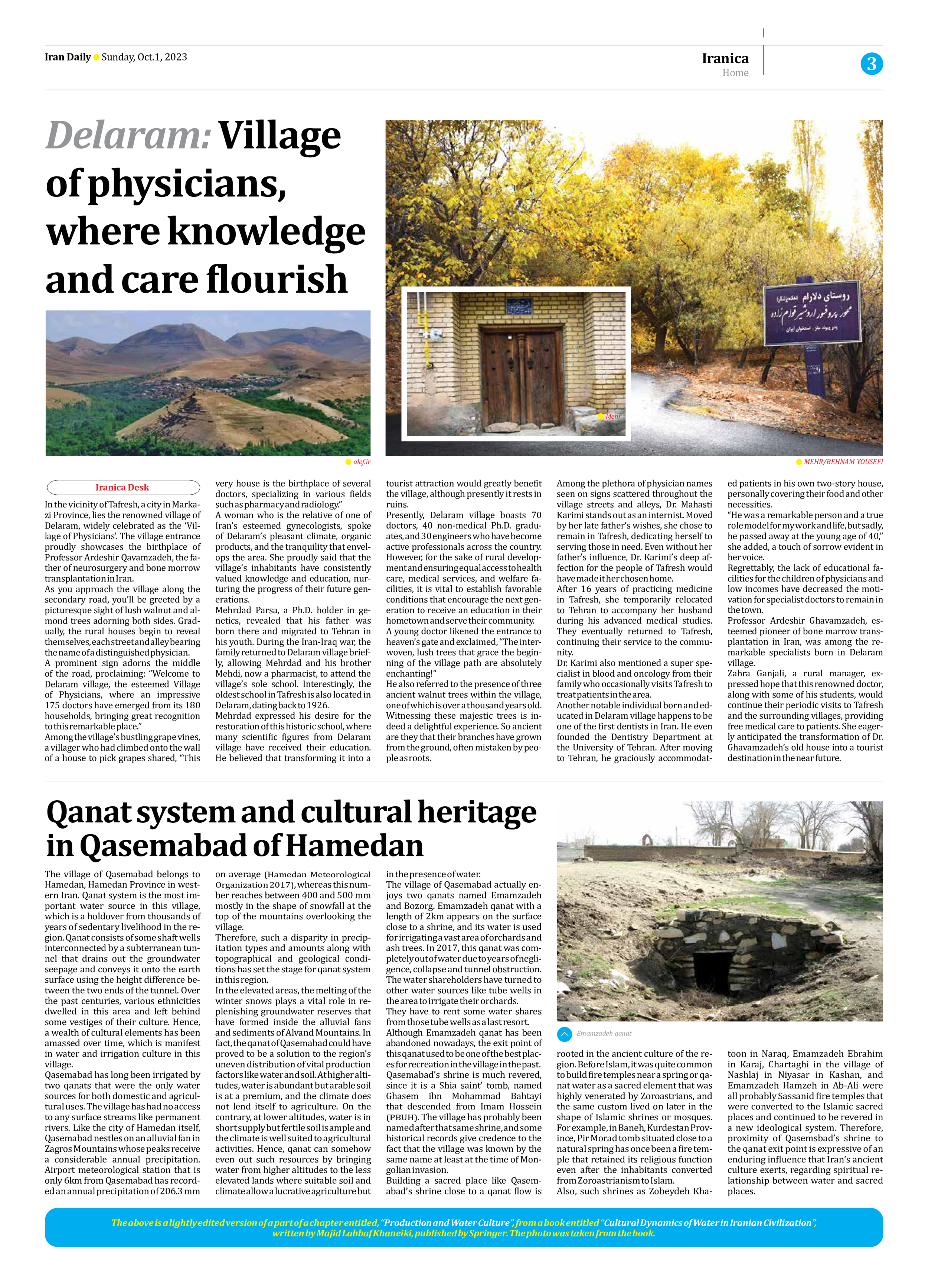
Qanat system and cultural heritage in Qasemabad of Hamedan
The village of Qasemabad belongs to Hamedan, Hamedan Province in western Iran. Qanat system is the most important water source in this village, which is a holdover from thousands of years of sedentary livelihood in the region. Qanat consists of some shaft wells interconnected by a subterranean tunnel that drains out the groundwater seepage and conveys it onto the earth surface using the height difference between the two ends of the tunnel. Over the past centuries, various ethnicities dwelled in this area and left behind some vestiges of their culture. Hence, a wealth of cultural elements has been amassed over time, which is manifest in water and irrigation culture in this village.
Qasemabad has long been irrigated by two qanats that were the only water sources for both domestic and agricultural uses. The village has had no access to any surface streams like permanent rivers. Like the city of Hamedan itself, Qasemabad nestles on an alluvial fan in Zagros Mountains whose peaks receive a considerable annual precipitation. Airport meteorological station that is only 6km from Qasemabad has recorded an annual precipitation of 206.3 mm on average (Hamedan Meteorological Organization 2017), whereas this number reaches between 400 and 500 mm mostly in the shape of snowfall at the top of the mountains overlooking the village.
Therefore, such a disparity in precipitation types and amounts along with topographical and geological conditions has set the stage for qanat system in this region.
In the elevated areas, the melting of the winter snows plays a vital role in replenishing groundwater reserves that have formed inside the alluvial fans and sediments of Alvand Mountains. In fact, the qanat of Qasemabad could have proved to be a solution to the region’s uneven distribution of vital production factors like water and soil. At higher altitudes, water is abundant but arable soil is at a premium, and the climate does not lend itself to agriculture. On the contrary, at lower altitudes, water is in short supply but fertile soil is ample and the climate is well suited to agricultural activities. Hence, qanat can somehow even out such resources by bringing water from higher altitudes to the less elevated lands where suitable soil and climate allow a lucrative agriculture but in the presence of water.
The village of Qasemabad actually enjoys two qanats named Emamzadeh and Bozorg. Emamzadeh qanat with a length of 2km appears on the surface close to a shrine, and its water is used for irrigating a vast area of orchards and ash trees. In 2017, this qanat was completely out of water due to years of negligence, collapse and tunnel obstruction. The water shareholders have turned to other water sources like tube wells in the area to irrigate their orchards.
They have to rent some water shares from those tube wells as a last resort.
Although Emamzadeh qanat has been abandoned nowadays, the exit point of this qanat used to be one of the best places for recreation in the village in the past.
Qasemabad’s shrine is much revered, since it is a Shia saint’ tomb, named Ghasem ibn Mohammad Bahtayi that descended from Imam Hossein (PBUH). The village has probably been named after that same shrine, and some historical records give credence to the fact that the village was known by the same name at least at the time of Mongolian invasion.
Building a sacred place like Qasemabad’s shrine close to a qanat flow is rooted in the ancient culture of the region. Before Islam, it was quite common to build fire temples near a spring or qanat water as a sacred element that was highly venerated by Zoroastrians, and the same custom lived on later in the shape of Islamic shrines or mosques. For example, in Baneh, Kurdestan Province, Pir Morad tomb situated close to a natural spring has once been a fire temple that retained its religious function even after the inhabitants converted from Zoroastrianism to Islam.
Also, such shrines as Zobeydeh Khatoon in Naraq, Emamzadeh Ebrahim in Karaj, Chartaghi in the village of Nashlaj in Niyasar in Kashan, and Emamzadeh Hamzeh in Ab-Ali were all probably Sassanid fire temples that were converted to the Islamic sacred places and continued to be revered in a new ideological system. Therefore, proximity of Qasemsbad’s shrine to the qanat exit point is expressive of an enduring influence that Iran’s ancient culture exerts, regarding spiritual relationship between water and sacred places.
The above is a lightly edited version of a part of a chapter entitled, “Production and Water Culture”, from a book entitled “Cultural Dynamics of Water in Iranian Civilization”,
written by Majid Labbaf Khaneiki, published by Springer. The photo was taken from the book.







